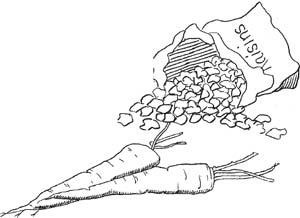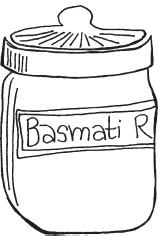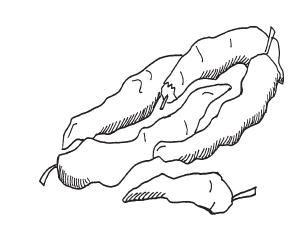Authors: Sally Fallon,Pat Connolly,Phd. Mary G. Enig
Tags: #Non-Fiction, #Reference, #Science, #Health
Nourishing Traditions: The Cookbook That Challenges Politically Correct Nutrition and The... (130 page)

In a heavy, flameproof casserole, melt butter and olive oil. Open cardamom pods and add seeds to casserole along with thyme, cloves, optional lemon rind and onion. Saute until onion is soft. Add rice and saute until milky. Pour in liquid, add salt and optional gelatin and bring to a rolling boil. Stir in carrots and raisins. Boil, uncovered, for about 10 to 15 minutes until the water has reduced to the level of the rice. Reduce flame to lowest heat, cover tightly and cook for at least 2 hours or as long as 3 hours. Do not remove lid during cooking.
The U.S. adventure in Viet Nam was, by world consensus, a folly on many levels. Perhaps, on the basic level of human nutrition, it was one of the sorriest stories of all. . .. For years, the guerilla bands of the Viet Minh and Viet Cong sustained themselves with a food supply system as simple and primitive as that of the Roman legions of Julius Caesar. Each man carried a little sack of whole rice and some salt. They added manioc leaves, from the jungle, and fish when possible. For years they stymied the elaborately equipped and lavishly rationed armies of the West. . .. When the victorious Viet Cong armies overran Saigon, they were exposed for the first time—like the Crusader arriving in the Holy Land centuries before—to the pause that refreshes, the Coke machine, the candy counter. It is their turn to accustom themselves to gluttony and La Dolce Vita and to eat and drink sugar openly in the street without shame. William Dufty
Sugar Blues

INDIAN RICE
Serves 6-8
2 cups long-grain brown basmati rice
1 medium onion, finely chopped
2 tablespoons butter
2 tablespoons extra virgin olive oil
1 teaspoon cumin seeds
1 teaspoon fenugreek seeds
2 teaspoons turmeric powder
4 cardamom pods
2 bay leaves
1 teaspoon salt
1 tablespoon gelatin (See
Sources
), optional4 cups
chicken stock
or combination of filtered water and stock
In a heavy, flameproof casserole, melt butter and olive oil. Open cardamom pods and add seeds to casserole along with onion, cumin and turmeric. Saute until onion is soft. Add rice and saute, stirring, until rice turns milky. Pour in liquid, add salt, optional gelatin and bay leaf and bring to a rolling boil. Boil, uncovered, for about 10 to 15 minutes until the water has reduced to the level of the rice. Reduce flame to lowest heat, cover tightly and cook for at least 1 hour or for as long as 3 hours. Do not remove lid during cooking.
Sodium, in the form of sodium chloride (salt), plays an essential role in digestion, starting from the moment food enters your mouth. Salt. . .activates the primary digestive enzyme in the mouth, salivary amylase. . .. Further down the digestive tract, in the stomach, sodium continues its good work. Sodium chloride generates hydrochloric acid in the parietal cells of the stomach wall, an essential secretion for proper digestion. . .. Vegetarians have been led to believe that their vegies supply all the salt they need in their diet. This is completely false. Why are salt blocks provided for grazing animals? They are provided with this salt source because every farmer knows that without it his vegetarian animals will get sick. . .. Salt is the single element required for the proper breakdown of plant carbohydrates into usable and assimilable human food. A salt-free, vegetarian diet is a sure ticket to the hospital and a premature old age. Vegetarians are also prone to sugar addiction. The physiological explanation for this: Glucosides in grains are not digested without the presence of salt. As the body is denied these natural sugars, a deficiency develops and there is an insatiable desire to eat sweets. William Campbell Douglass, MD
Second Opinion

MEXICAN RICE
Serves 6-8
2 cups long-grain brown rice
1 medium onion, finely chopped
2 tablespoons butter
2 tablespoons extra virgin olive oil
1 teaspoon annatto seeds (available in Latin American markets)
1 teaspoon cumin seeds
¼ teaspoon red chile flakes
1 teaspoon dried oregano
1 teaspoon salt
4 cups
chicken stock
or combination of filtered water and stock1 tablespoon gelatin (See
Sources
), optional1 clove garlic, peeled and mashed
2 tablespoons green olives, chopped (optional)
In a heavy, flameproof casserole, melt butter and olive oil. Saute annatto seeds in oil for about 5 minutes, or until oil turns yellow, and remove with a slotted spoon. In the same oil, saute onion with red chile flakes and cumin seeds until onion is soft. Add rice and saute until milky. Pour in liquid, add salt, optional gelatin, oregano and garlic and bring to a rolling boil. Boil, uncovered, for about 10 to 15 minutes until the water has reduced to the level of the rice. Reduce flame to lowest heat, cover tightly and cook for at least 2 hours or as long as 3 hours. Do not remove lid during cooking. Just before serving, remove lid and stir in optional olives.
Despite the efforts of ACT [Action for Children's Television], 600 million dollars is now spent yearly on children's advertising, 30 million of it by the cereal industry. This advertising, which necessarily glosses over such drawbacks as tooth decay in peddling candy to children, is adroit at deception. In 1982 "Sugar Smacks" was rechristened "Honey Smacks," presumably because honey is healthier. Of course, both versions of the cereal contain 57 percent refined sugars.
Although the motto of the market place, supposedly, is to "give the people what they want," the reality is more a matter of giving the people whatever increases one's market share. Most parents are trying to wean their children from excessive sweets; yet supermarkets and drug stores across the country always have candy prominently displayed at checkout counters—where parents are stuck in line with restless, candy-craving children. Kroger's, a Cincinnati grocery chain that conscientiously established a no-candy lane, prompted a representative of the national Candy Wholesalers Association to object: "Discipline begins with the parent, and our attitude is the product should be available." So much for giving the people what they want. Joseph D. Beasley, MD and Jerry J. Swift, MA
The Kellogg Report

MEXICAN RICE CASSEROLE
Serves 8
4 cups
basic brown rice1½ cups grated Monterey Jack or Cheddar cheese
2 bunches green onions, chopped
½ cup pitted black olives, chopped
1 cup
pickled red peppers
, chopped or 2 small cans green chile peppers, chopped1 cup
piima cream
or
creme fraiche
This delicious dish is only for those with a high tolerance to milk products. Combine all ingredients except ½ cup grated cheese and pour into a buttered casserole. Top with cheese and bake at 350 degrees for about 30 minutes.
GREEK RICE
Serves 6-8
2 cups
basic brown rice2 onions, finely chopped
2 sticks celery, finely chopped
3 tablespoons extra virgin olive oil
2 cloves garlic, peeled and mashed
2 tablespoons sesame seeds, toasted
2 tablespoons
pepitas2 tablespoons
crispy pine nuts¼ cup freshly chopped mint
grated rind and juice of 1 lemon
½ teaspoon oregano
sea salt and pepper
Saute onions, celery and garlic very gently in olive oil until soft. Mix together all ingredients and season to taste. Greek rice may be used as a stuffing in grape leaves, tomatoes, or eggplant, or served on its own.
Dr. Price was often called to the bedsides of dying individuals, when last rites were being administered. He brought with him two things—a bottle of cod liver oil and a bottle of high vitamin butter oil from cows eating growing grass. He put drops of both under the tongue of the patient—and more often that not the patient revived. He was puzzled by the fact that cod liver oil alone and butter oil alone seldom revived the dying patient—but the two together worked like magic. Research into prostaglandins may supply the answer. High vitamin butter may be rich in arachidonic acid (AA) and possibly other factors needed for the omega-6 pathway; and cod liver oil is rich in eicosapentaenoic acid (EPA) needed for the omega-3 pathway. In addition, the saturated fatty acids in butter help the unsaturated fatty acids in cod liver oil to work more efficiently.
Many delicious traditional dishes provide a synergystic combination of fatty acids of the omega-3 family with fatty acids of the omega-6 family and saturated fatty acids—lox and cream cheese, caviar and sour cream, liver and bacon, salmon and Bernaise sauce, dark green vegetables with butter, cream cheese and flax oil. In India, milk products provide AA and shorter chain fatty acids while insects provide the longer chain fatty acids of the omega-3 chain. Fish, pork and coconut oil provide all the necessary fatty acids in the Polynesian diet; American Indians valued fish, bear fat and oil of the evening primrose plant. Traditional combinations of rich foods, therefore, need not be avoided. They provide factors that open both lanes of the prostaglandin pathway, creating a wide and open highway to skip along for renewed vitality and vibrant health.
Tripping Lightly Down the Prostaglandin Pathways

